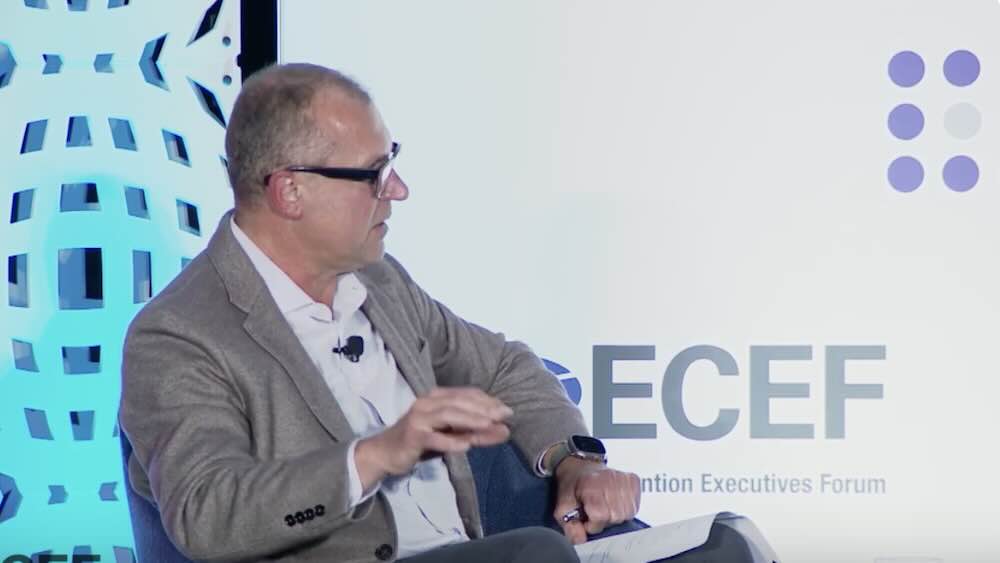


Hervé Sedky, president and CEO of Emerald, served as the moderator of ECEF’s “Headwinds” session.
In Washington, D.C. on May 28, the ECEF audience — a record 270 executives — was asked to use their devices to type in a one-word prognosis for U.S. events in the next 18 months for an instant word cloud. The words “challenging” and “uncertain” dominated the screen.
Which isn’t surprising given the major shifts brought about by the current U.S. administration. In response, ECEF had its own single-word session: “Headwinds,” which spoke directly to these realities. The session was moderated by Hervé Sedky, president and CEO of Emerald, whose portfolio includes 142 annual events and 16 media properties.
‘Broader Impacts on Credibility’
First to speak was Isabelle Icso, executive director of international policy for the U.S. Chamber of Commerce, who talked about the primary and secondary effects of President Trump’s tariffs in the U.S. What she finds most concerning, she said, is the “broader impacts more generally on [the United States’] credibility as a trading and defense partner.” She cited data suggesting that countries aren’t necessarily canceling existing contracts with the U.S., but they’re not entering into new ones. “Countries have a lot less patience,” she said, “this time around with the Trump administration.”
When Sedky asked her to highlight the potential effects on the events industry over the next year, Icso noted that from the trade-show industry perspective, tariffs would have an impact on the construction of booths, because the benchmark prices of steel and aluminum have gone up, in addition to other cost increases that would have an impact. “The crux of a trade show is really to sell goods and make connections,” she said, “and if you’re selling a good that’s an X-percent higher price because of these tariffs, that’s certainly going to be front and center.” Of course, she added, this depends on the sector/s represented at the trade show — those expected to be most affected in the short and long term include construction output, agriculture, followed by retail, food, and motor vehicles.
In terms of advice, Isco recommended that the audience get a better understanding of their supply chains. “The better grasp of your supply chains that you have, the more agile you’ll be able to be and the quicker you’ll be able to react to these policies when they get rolled out.”
‘No Question That We’ve Got Some Challenges’
Next up was Kevin Hinton, the managing director of group travel for the U.S. Travel Association, whose primary priorities, he told the audience, are to establish travel as essential and responsible and to improve the travel experience from Point A to Point B. He presented the audience with a few stats to set the stage: Travel is a $1.3 trillion industry in the U.S., with group travel representing $130 billion.


That figure, he said, is something the U.S. Travel Association is keeping a close eye on. He shared that when he was at IMEX in Frankfurt the week prior, he heard European participants express concerns about travel to the U.S. being too risky and wanting to “wait it out.” In speaking with event organizers, Hinton said, he recognized that some are seeing a 10-percent loss of international attendees.

As far as engaging international attendees, Hinton said this may be a good opportunity to look at virtual and hybrid options to build relationships with audiences in the short term. He also suggested that for some events, organizers may look at shifting their focus for attracting attendees from the tried-and-true markets to some growth markets around the world.
Sedky confirmed that this is something Emerald has experienced at its events. “While we’ve clearly been hit by a reduction in travelers from some countries, China and Canada in particular,” Sedky said, “we are seeing a real increase [in travelers] from other countries — Brazil, Turkey, the Middle East — where we had very little attendance in the past.”
‘Slowing Us Down’
Rich Scarfo, president of HLTH — whose events, HLTH US, HLTH Europe, and ViVE, attract health-care leaders and innovators — was the final speaker. He began his talk by saying that “the key thing for us right now is looking at the uncertainty. The biggest thing that we’re seeing affecting our events immediately — because all of this is very early, we really don’t know what the next year will look like — [is] an immediate halt in government travel. That’s a big problem, especially in health care. We’re seeing leaders who we need to drive key conversations not able to attend the event. We’re also seeing other government leaders who are coming to our event and paying on their own. I think the thought leadership aspect of what we will lose is important, the networking aspect, because you look at an event like HLTH or ViVE where 55 percent of our audience is VP level and above — these are targeted events in terms of being marketplaces, thought-leadership gatherings, and networking. So that piece of that will be very compromised in the very near term — we’re seeing that already for HLTH Europe and for HLTH in October.”
Scarfo said that HLTH is in “replace-and-then-fix mode,” analyzing what they may be losing from their events in sectors like government and how they can fill in those gaps. “Not all of this will be bad in the next year and I think that’s the thing that we have to focus on,” he said. “I think COVID shut us down and I think what we’re in now is just slowing us down. If you didn’t look at COVID in a way that you came out the other side of it in a better place, not just where you were [before], then you’ve already lost. It’s the same approach that we’re taking right now. So we’re looking at how do we bring in other voices. … we hear a lot in health care around underserved communities, the most vulnerable, those without heath care — and those are being hit the hardest right now because a lot of the programs that are disappearing served those communities. What we’re seeing step into that space are more philanthropy [organizations], foundations, and different approaches.”
Scarfo pointed out that HLTH events focus on health-care innovation “and at times like this, events focusing on innovation can thrive, because you have to find other ways of doing things. The U.S. is resilient in a lot of ways. I do think the challenge we’re facing right now is we’re going through such an erratic period where things don’t make sense. I think if it continues, we’ll have to quiet some of that and really focus on the industry issues that will drive us forward.”
When Sedky asked Scarfo how he is managing his staff during this period of flux, Scarfo noted that he has a very diverse team. “We purposefully hired a young team without event experience for certain things that we do because it gives us a very creative approach. We’ve surrounded that team with a more experienced and slightly older team (like me) that really helps us build the company with both a creative approach but a sound business model. So what we’re finding is that the younger members of the team are very expressive. They’re very willing to discuss the things that they’re worried about and the things they stand for and the things that are bothering them. There’s been a lot of that in the office. There’s been a request for more team outings and things like that.” Scarfo said he has been struck by how quickly his team has been impacted and their response, saying that it reflects what “they’re passionate about — and health care, as we say, is personal.”
Sedky asked what kind of advice he could give leaders in the audience, and Scarfo said that he could only speak from his perspective. “We launched HLTH and ViVE and HLTH Europe with a different model in mind and that was to step away from the massive booths on the show floor and 30,000-40,000 people. Not that they’re bad — I think they’re wonderful events and they serve a purpose. We started a model that right-sized activations and that’s serving us well right now,” he said.
“What we’re seeing is a shift — not a return on investment but on experience and value.” The upcoming HLTH event in October in Las Vegas has 900 sponsors, and he said a telling data point was that they had already sold 300 booth packages, “meaning that’s a company coming in and not bringing their own booth. That’s double what it was last year already and we’re still going. I think [it’s key to find] creative ways to help companies engage because in uncertain times the first thing that goes is budgets get reduced, the number of people that goes to shows gets downsized.”
He said their focus is to help find cost-effective ways for sponsoring companies to activate in alignment with their vision. That includes a strong hosted-buyer program. “We already have 8,000 meetings sold for HLTH this year. Last year, we capped out at 6,000. So what that’s telling us is twofold: On the buyer’s side, they don’t pay to come to the event and we’ve seen a surge in applications. On the sponsor side, they really need those meetings because regardless of what’s happening, people still need to do business.”
And he added one more strategic opportunity during the Q&A at the end of the session that echoed both Hinton and Sedky’s advice earlier in the session: Look to attract audiences from other markets. For the first time, HLTH will feature a Latin American summit, bringing 350 health-care executives from that corner of the world who are first-time attendees.
Michelle Russell is editor in chief of Convene.





